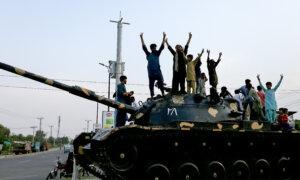Commentary
President Donald J. Trump announced on May 10 that India and Pakistan had agreed to a “full and immediate ceasefire.” It marked the end of a rapid escalation between two nuclear-armed states and the reassertion of U.S. strategic influence under a new administration.
What led to the cease-fire wasn’t just phone diplomacy. It was the careful application of leverage, and the key to understanding it lies in the International Monetary Fund (IMF) vote that happened the day before.
On May 9, the executive board of the IMF approved a $2.3 billion loan package for Pakistan: $1 billion under the Extended Fund Facility and $1.3 billion under the Resilience and Sustainability Facility.
At first glance, this appeared to be a routine bailout. But something about the vote didn’t add up.
Why the Vote Was Controversial
There had been serious doubts the loan would pass. The previous IMF agreement had required Pakistan to assist NATO’s arms transfers to Ukraine. That deal was controversial, and the Trump administration has since shifted away from indefinite commitments in Ukraine or NATO. Meanwhile, India had lobbied hard against the new loan, arguing that it would indirectly fund terrorism against its citizens.Yet when the vote came, India abstained. So did China and Russia. The United States and United Kingdom voted in favor.
Why would the United States support a loan to a near-bankrupt state that had just triggered war with India?
The answer lies in what followed: the cease-fire.
A 3-Front Strategy: India, Pakistan, and China
President Trump did not just stop a war; he may have realigned three major geopolitical dynamics in one move.- India: Resuming a Trade Reset
The answer may lie in the tariff reset strategy President Trump initiated immediately upon taking office. India was one of the first targets of this economic diplomacy. Trump had labeled India the “tariff king,” and negotiations had begun to reduce duties on key American exports, especially agriculture.
Vice President J.D. Vance was dispatched to New Delhi—an unusual gesture signaling the importance of the deal. Before the recent terror attack, reports indicated that the two countries were close to reaching agreement.
India’s abstention, then, appears not as a diplomatic lapse, but as a calculated step to get the talks back on track. A cease-fire, secured through an IMF deal, creates the space needed to finalize a bilateral trade realignment.
- Pakistan: Cease-Fire in Exchange for Bailout
A cease-fire, brokered by the United States, gave Pakistan breathing room—but it wasn’t charity. The loan came with quiet strings.
Historically, Pakistan has served as a logistical node for NATO, especially during the Ukraine conflict. The UK, for example, routed arms through Pakistani territory in 2022, using the Nur Khan Airbase to airlift munitions to Europe.
Even so, the United States itself has signaled a strategic pullback from NATO. More importantly, internal divisions within the American security apparatus over Pakistan—some pro, some anti—meant the decision to back a loan had to deliver concrete returns.
That return? A full cease-fire. And perhaps something more.
- China: Silent, but Excluded
China did not support the loan.
This is surprising, because if anyone stood to benefit from a Pakistani windfall, it was China. Much of Pakistan’s military procurement goes to Chinese manufacturers.
The likely explanation: U.S. negotiators inserted a key condition into the loan—that funds could not be used to purchase Chinese or Russian arms. If true, this would directly curtail Beijing’s defense exports and influence in the region.
Both China and Russia abstained.
Three Outcomes, One Move
The cease-fire wasn’t the end goal. It was a midpoint. A tool. And one that helped unlock at least three strategic victories for the United States:- Restarted trade talks with India
- Deescalated a potential nuclear conflict
- Blocked Chinese arms from a key client state
A Doctrine Emerges
In a time of institutional distrust and endless conflict, President Trump’s foreign policy continues to break with the consensus-driven, globalist model of the past.Instead of lectures, he offers terms. Instead of appeasement, conditions. Instead of silence, clarity—delivered through results.
As the Trump administration crosses its 100-day mark, this quiet cease-fire—engineered through an IMF vote—may go down as a case study in 21st-century statecraft.
It didn’t come through summits. It came through leverage. And if this is a sign of things to come, America’s era of deal-making diplomacy is just getting started.



